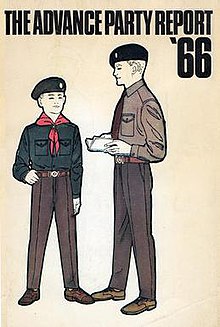The Chief Scouts' Advance Party Report

Cover of the Popular edition
|
|
| Author | The Boy Scouts Association |
|---|---|
| Language | English |
| Genre | Non-fiction |
| Publisher | Kent Paper Company Ltd (first edition) |
|
Publication date
|
1966 |
| Media type | |
The Chief Scout's Advance Party Report was a publication produced in 1966 by The Boy Scout Association in the United Kingdom, intended to modernise the Scout Movement. The report was attempting to address falling numbers within the Movement.
The Chief Scout's Advance Party was formed in January 1964, when 24 Scout Leaders under the age of 45 were invited to "study all apects of the future of Scouting and to make recommendations, after consultation with the Movement, to the Chief Scout as to the development of the Movement, both in the immediate future and for the 1970s."
The Advance Party met as a body for six weekends, with various sub-committees holding an additional 166 meetings and the chairmen of these committees meeting on three occasions.
Chairman: The Chief Scout, Sir Charles Maclean
Secretary: E.W. Hayden; Training Secretary, Headquarters
The final report to the Committee of the Council was 200,000 words long. This was reduced to 50,000 words in a published "Popular Edition" through summarising and omitting many of the arguments relating to the 409 recommendations.
1 That the Boy Scouts Association be renamed as The Scout Association.
2 Wolf Cubs be renamed Cub Scouts.
3 That the Scout and Cub Scout Promise be the same, with the removal of the phrases "On my honour" and "at all times".
4 That the original Scout Law be re-written, becoming-
5 That a new training and advancement scheme be introduced.
6 All Sections should use the same Scout salute.
7 That "Be Prepared" be the motto for the whole Scout Movement.
8 That the minimum age for entry into the Scout Movement be 8 years, with no pre-Cub training.
9 That the maximum age for membership of a Training Section of the Movement be 20 years.
10 That there be three Training Sections in the Movement;
11 That Scout Troops of approximately 36 members be formed by amalgamation or pooling of resources of smaller troops.
12 That the registration of Lone Scouts be discontinued.
13 That a set of minimum standards be introduced, with Groups failing to meet these standards being closed;
14 That a maximum age-limit for Scouters and Commissioners be introduced.
15 That there be an increase in the number of paid Scouters.
16 That shorts will only be worn as part of the uniform by members of the Cub Scout section.
...
Wikipedia
